1. Pickled Pig Lips – Louisiana
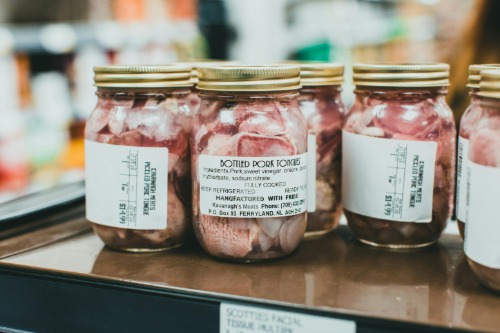
Pickled pig lips are one of Louisiana’s more eyebrow-raising gas station snacks, and they live up to their reputation. Bright red, vinegary, and floating in giant jars, they’re often sold alongside pickled eggs and sausage. The texture is a chewy, rubbery challenge, and the sharp brine can catch you off guard. Still, locals treat them as a salty treat, usually chased with a cold beer, according to Cindy Johnston from NPR.
To most visitors, the idea of munching on pig lips seems more like a dare than a delicacy. But for some Louisianans, they’re nostalgic, bold, and oddly satisfying. The strong, meaty flavor is unlike anything else you’ll find in the snack aisle. It’s not for everyone—but that’s part of the charm.
2. Akutaq (Eskimo Ice Cream) – Alaska
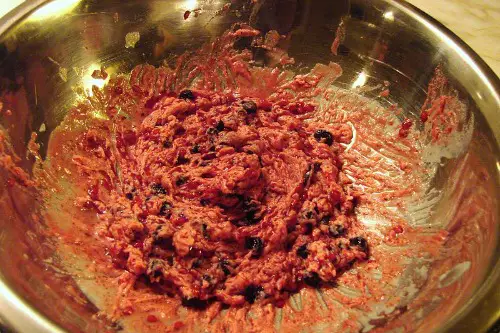
Akutaq, often referred to as Eskimo ice cream, is unlike any frozen dessert you’ve ever tasted. Traditionally, it’s made with whipped animal fat—like seal or caribou—mixed with snow, berries, and sometimes fish. Modern versions might use Crisco, but the essence remains: a creamy, fatty blend designed to provide energy in Arctic conditions. The mix of sweet berries and savory fat is surprisingly balanced.
For many Alaskans, especially Indigenous communities, akutaq is more than just food—it’s a celebration dish. It’s often eaten at special occasions or shared among families during seasonal gatherings. To outsiders, the combination of ingredients can be off-putting, but it holds deep cultural significance. It’s a reminder that survival food can also be deeply meaningful and delicious.
3. Rocky Mountain Oysters – Colorado
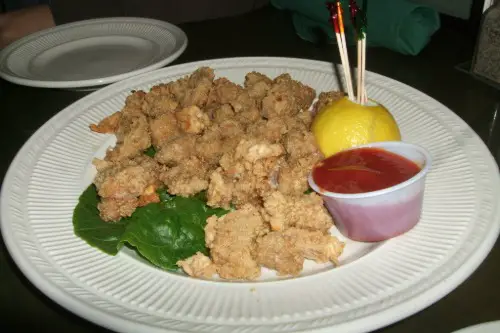
Despite the name, Rocky Mountain oysters contain no seafood whatsoever, Kevin Farrell from USA Today explains. They’re actually bull testicles, sliced, breaded, and deep-fried to golden perfection. Traditionally eaten by ranchers to avoid waste, they’ve become a state fair novelty and bar snack with a cult following. The flavor is surprisingly mild, often compared to chicken or tender pork.
Still, the mental hurdle is what makes them infamous. Tourists may recoil when they find out what’s actually on their plate. But for those willing to give it a shot, the crispy coating and tender interior can be a surprise hit. Just don’t ask too many questions before the first bite.
4. Goetta – Ohio
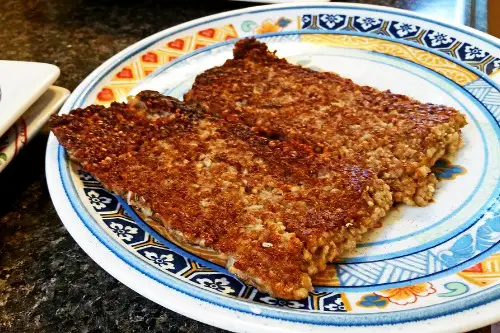
Goetta, pronounced “get-uh,” is Cincinnati’s answer to breakfast sausage—with a twist that tends to throw outsiders off, according to Linnea Covington from The Spruce Eats. It combines ground pork and beef with steel-cut oats, seasoned and pan-fried into thick slices. The oats give it a grainy, almost chewy texture that’s totally unlike your average sausage. It’s hearty, filling, and rich in Midwestern character.
Locals are fiercely loyal to this dish, often pairing it with eggs or piling it into breakfast sandwiches. To the uninitiated, the mixture of meat and oats can sound—and feel—a little strange. But once you get past the texture, its flavor is comforting and savory. It’s a regional favorite that’s hard to forget once you’ve tried it.
5. Lutefisk – Minnesota
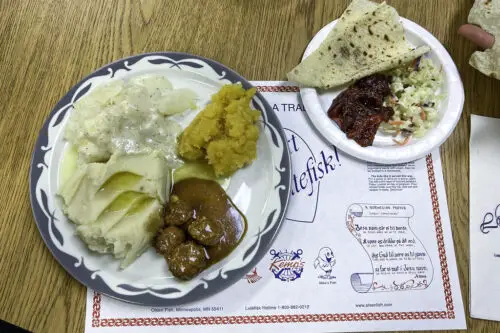
Lutefisk is a dish that even some Minnesotans approach with caution, Anna Pollock form Minnesota Monthly shares. It starts as dried whitefish, which is soaked in lye, then carefully rinsed and rehydrated until it reaches a slippery, gelatin-like consistency. The smell is famously pungent, and the taste—well, it’s definitely acquired. It’s a culinary holdover from the state’s Scandinavian settlers.
Usually served during the holidays, lutefisk is a love-it-or-leave-it kind of dish. It’s often paired with creamy sauces, butter, or potatoes to tone down the fishy funk. While many younger locals dodge it, older generations embrace its traditional roots. Tourists, on the other hand, are usually left wondering how anyone eats it at all.
6. Chitlins – Georgia
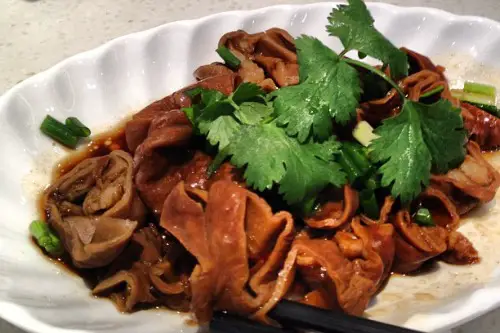
Chitlins, short for chitterlings, are boiled pig intestines that have long been part of Southern cooking traditions, according to Steve Bender from Southern Living. In Georgia, they’re often fried after boiling and served with hot sauce or vinegar. The biggest obstacle isn’t the flavor—it’s the smell, which is undeniably intense during preparation. Cleaning and cooking chitlins is a labor of love.
Though their aroma can clear a room, chitlins have deep cultural roots and are often associated with soul food and family gatherings. They have a distinct, earthy taste and a soft texture that some find comforting. Others, especially visitors unfamiliar with the dish, are less enthusiastic. Either way, they’re a cornerstone of Southern food history.
7. Garbage Plate – New York
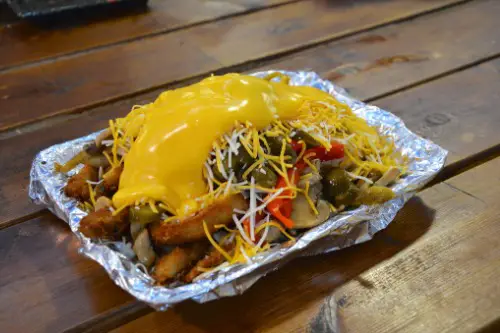
The Garbage Plate is a legendary dish from Rochester, New York, and it’s exactly as chaotic as it sounds. This heaping pile of food typically includes home fries, macaroni salad, baked beans, hamburger meat, and hot sauce—all piled onto a single plate. Originally created as a cheap, filling meal for college students, it has since become an iconic regional specialty.
Despite its name, the Garbage Plate is beloved for its mix of flavors and satisfying heartiness. The layers of starch, meat, and sauce create a greasy, indulgent experience that’s perfect for late-night cravings. While it might not be the most aesthetically pleasing dish, it’s a must-try for anyone visiting upstate New York. Just don’t expect to walk away hungry.
8. Boiled Peanuts – South Carolina
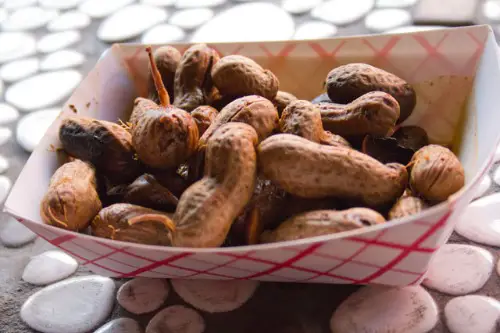
In South Carolina, boiled peanuts are a beloved snack that’s quite different from your typical peanut experience. These peanuts are boiled for hours in salty water, transforming them into a soft, bean-like texture that might initially seem off-putting to those expecting a crunchy snack. They’re messy, soggy, and not exactly something you’d grab for a quick bite, but for South Carolinians, they’re an iconic treat that’s often enjoyed during festivals or while tailgating.
The soft, mushy texture of boiled peanuts is something that takes a bit of getting used to, especially for those accustomed to roasted or salted peanuts. The salty brine gives them a rich, savory flavor that’s perfect for snacking. While they might seem like an odd dish to newcomers, locals swear by them, often citing the unique experience of enjoying a warm, comforting bowl of boiled peanuts. If you’re ever in South Carolina, give them a try—but be ready for a completely different peanut-eating experience.
9. Fried Brain Sandwich – Indiana
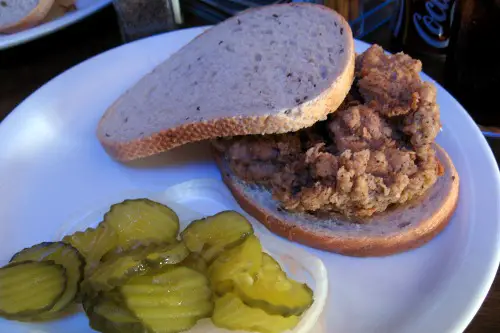
In Indiana, the fried brain sandwich is a dish that’s not for the faint of heart. Made from calf brains, this sandwich was once a popular item, especially before fears about mad cow disease began to surface. The brains are battered, fried, and served between two slices of bread, often with lettuce, tomato, and other condiments. The texture of the brain is incredibly smooth and creamy, almost like custard, which contrasts with the crispy exterior.
For those willing to try it, the fried brain sandwich offers a unique culinary experience. While the idea of eating brains might be unsettling for many, fans of the dish claim that it’s surprisingly tasty, with a rich and delicate flavor. In the past, the sandwich was a common fixture at local diners and sandwich shops, though its popularity has waned. If you’re feeling adventurous and curious about Indiana’s regional food traditions, the fried brain sandwich is a must-try for those who are open to exploring unusual flavors.
10. Livermush – North Carolina

Livermush is a dish that takes pork to a whole new level, especially in North Carolina. It’s made from pig liver, head parts, and cornmeal, then fried until crispy. Served either as a breakfast item or in a sandwich, livermush is beloved by many locals, despite its off-putting ingredients. The flavor is rich and savory, with the cornmeal adding a hearty texture that complements the pork.
Livermush is a staple in North Carolina, particularly in the western parts of the state, where it’s often enjoyed with grits or eggs. While it may not be a dish for everyone, especially those who aren’t fans of liver, it has a loyal following among those who appreciate its unique taste. For the uninitiated, the idea of eating pig liver and other head parts may seem unappetizing, but it’s a cherished part of the state’s culinary heritage. If you’re looking to dive into North Carolina’s regional foods, livermush offers a distinctive flavor that’s sure to leave an impression.
11. Fried Kool-Aid – California
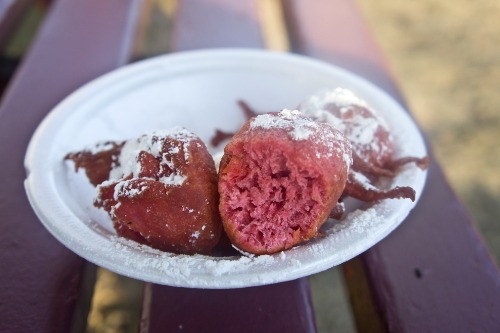
Fried Kool-Aid might sound like a bizarre novelty food, and that’s because it is. This unique treat comes from California, where fair food vendors decided to take the iconic powdered drink mix and turn it into a fried dessert. The Kool-Aid powder is mixed into dough, then deep-fried like a donut hole. The result is a sugary, bright red ball of dough that’s sweet, greasy, and oh-so-sugary.
Despite the eye-catching color and sweet flavor, fried Kool-Aid is a controversial dish. Some people love the sugar rush, while others find the concept overly indulgent and overly artificial. The treat is typically dusted with sugar and served hot, which makes it a tempting option for anyone with a sweet tooth. However, for many, it’s more of a novelty than a regular craving. If you’re in California and happen to visit a fair or carnival, fried Kool-Aid is an odd but memorable snack that reflects the state’s penchant for inventing outlandish foods.
12. Scrapple – Pennsylvania
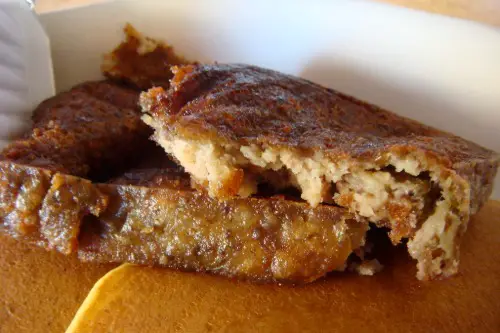
Scrapple is a beloved breakfast dish in Pennsylvania, particularly among the Pennsylvania Dutch. It’s made from the leftover scraps of pork—usually bits of the head, liver, and other parts—mixed with cornmeal and spices, then formed into a loaf and fried until crispy. The result is a savory, crispy exterior with a soft, mushy interior. Some people love it for its rich, meaty flavor, while others find it hard to get past the fact that it’s made from some of the less desirable parts of the pig.
Often served with eggs, scrapple is a popular breakfast item in Pennsylvania, especially in rural areas. It’s a dish that’s both hearty and filling, perfect for starting the day. While it might sound off-putting to some, scrapple has been a part of the Pennsylvania food scene for centuries. For those looking to experience traditional Pennsylvania Dutch cuisine, scrapple is an essential dish that showcases the resourcefulness of early settlers in using every part of the pig.
13. Burgoo – Kentucky
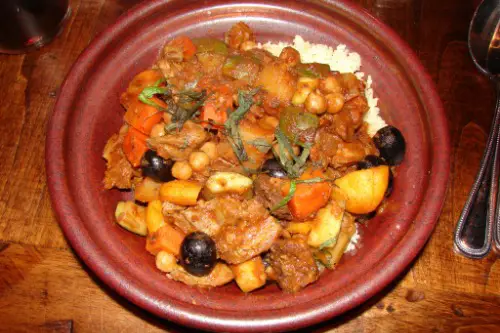
Burgoo is a thick, hearty stew that’s a true reflection of Kentucky’s diverse culinary history. Traditionally made with whatever meat was available—often squirrel, possum, or raccoon—burgoo has evolved over time to include more common meats like chicken and beef. The stew is slow-cooked for hours, allowing the flavors to meld together into a rich, flavorful dish. It’s a meal that speaks to Kentucky’s history of resourcefulness and making use of whatever was available.
While the original recipe called for wild game, modern versions of burgoo are often made with a mix of meats, vegetables, and spices. It’s a dish that’s typically served at festivals, family gatherings, and barbecues, where it’s often enjoyed with cornbread or biscuits. The wide variety of ingredients gives burgoo a unique flavor profile that can differ from batch to batch. Whether you’re tasting a traditional version or a more contemporary one, burgoo is an essential part of Kentucky’s culinary identity, representing the state’s history and love for hearty, satisfying meals.
14. Slopper – Colorado
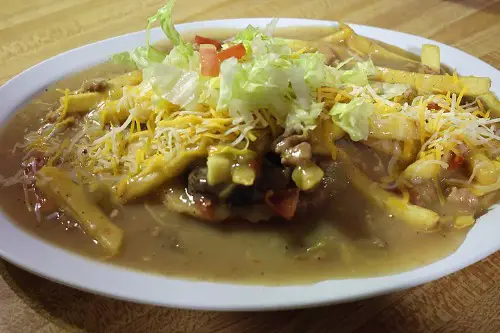
A slopper is Pueblo, Colorado’s messiest claim to culinary fame—and it’s not for neat eaters. Picture a cheeseburger served open-faced, then drowned in green or red chili until it’s practically unrecognizable. It’s eaten with a fork and often comes with a side of napkins… lots of napkins. It’s spicy, saucy, and absolutely satisfying.
The name doesn’t do it any favors, and tourists often raise eyebrows at the chili-soaked presentation. But locals swear it’s the best way to eat a burger—especially after a night out. The combination of gooey cheese, juicy meat, and spicy chili hits all the right notes. Messy? Absolutely. Delicious? Even more so.


